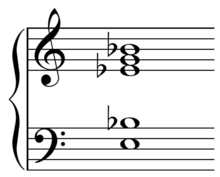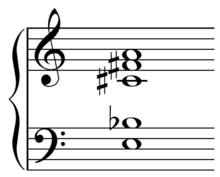Upper structure
In jazz music, the term upper structure or upper structure triad refers to a voicing approach developed by jazz pianists and arrangers defined by the sounding of a major or minor triad in the uppermost pitches of a more complex harmony.[1]
Examples
Example 1: Below, a common voicing used by jazz pianists is given for the chord C7♯9 (C major chord with a minor 7th, and extended with an augmented 9th).
In the lower-stave the notes E♮ and B♭ are given. These form a tritone which defines the dominant sound, and are the major 3rd and flattened 7th of the C7♯9 chord.
In the upper-stave the notes E♭, G, and B♭ are given together: these form an E♭ major triad.
This E♭ major triad is what would be called the upper structure. Considered in relation to the root C, the notes of this E♭ major triad function, respectively, as the sharpened ninth (actually a flattened tenth, enharmonically equal to the sharpened ninth which forms the root of the E♭ major chord), fifth, and seventh in relation to that root.
(Note: the root C is omitted here, and is often done so by jazz pianists for ease of playing, or because a bass player is present.)
Example 2: The following example illustrates the notes of an F♯ minor triad functioning as part of a C13♭9♯11 chord (C major chord with a minor 7th, minor ninth, augmented 11th, and major 13th):
In relation to the root of C, the C♯ (enharmonic with D♭) functions as a flattened ninth, the F♯ functions as a sharpened eleventh, and the A functions as the thirteenth.
Application
Determining which upper structure(s) can be juxtaposed on top of a chord is achieved by considering the relationship between a particular chord and the scale it implies. An example follows:
- The chord C13♭9♯11 contains the following notes, from the root upwards: C, E, G, B♭, D♭, F♯, A;
- The following octatonic scale contains all of these pitches, and fits or matches up with the C13♭9♯11 chord: C–D♭–D♯–E–F♯–G–A–B♭–C;
- Choosing from the available pitches given by this octatonic scale, we can construct a number of major and minor triads: E♭ major (E♭–G–B♭), E♭ minor (E♭–G♭–B♭), G♭ major (G♭–B♭–D♭), F♯ minor (F♯–A–C♯), A major (A–C♯–E), A minor (A–C–E);
- Juxtaposing any of these triads over the original C13♭9♯11 chord will provide a potential upper structure that agrees with this chord type and the related scale.
Shorthand notation
Common jazz parlance refers to upper structures by way of the interval between the root of the bottom chord and the root of the triad juxtaposed above it.[2] For instance, in example one above (C7♯9) the triad of E♭ major is a (compound) minor 3rd away from C (root of the bottom chord). Thus, this upper structure can be called upper structure flat three, or US♭III for short.
Example two (C13♭9♯11) is called upper structure sharp four minor, and can be written shorthand as US♯iv.
Other possible upper structures are:
- USII – e.g. D major over C7, resulting in C13♯11
- US♭V – e.g. G♭ major over C7, resulting in C7♭9♯11
- US♭VI – e.g. A♭ major over C7, resulting in C7♯9♭13
- USVI – e.g. A major over C7, resulting in C13♭9
- USi – e.g. C minor over C7, resulting in C7♯9
- US♭ii – e.g. D♭ minor over C7, resulting in C7♭9♭13
- US♭iii – e.g. E♭ minor over C7, resulting in C7♯9♯11
Recordings
A quintessential example of a pianist using upper structures is Bill Evans's playing on "Blue in Green", from Miles Davis's Kind of Blue.

